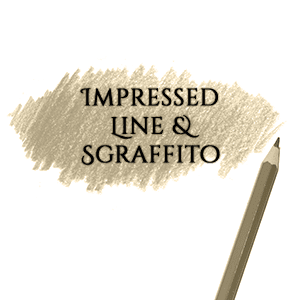Colored Pencil Tips & Techniques:
Creating Patterns and Textures with Colored Pencils
It's All About Colored Pencils!
When using colored pencils, one can create various patterns and life-like textures by using specific tools and applying various techniques. For example, some patterns or textures can be created by applying layers of colors and adding distinct details or you can create a pattern or texture by using an eraser.
There are many wonderful resources out on the market today on creating various patterns and textures for colored pencil artists. One wonderful resource for your colored pencil library is a book by colored pencil artist Gary Greene, Creating Textures in Colored Pencil. The book goes into detail about how to create various life-like textures using colored pencils along with step-by-step demonstrations. Two other good resources for creating textures with colored pencil is 101 Textures in Colored Pencil: Practical step-by-step drawing techniques for rendering a variety of surfaces & textures and The Complete Book of Textures for Artists: Step-by-step instructions for mastering more than 275 textures in graphite, charcoal, colored pencil, acrylic, and oil Both books are by artist Denise Howard and each is a great guide in learning how to use specific tools and techniques to create different types of textures using colored pencils.
Tips and Techniques for Creating Different Textures or Patterns with Colored Pencils.
- To create a pattern or texture, try using the side of the pencil lead to create different patterns and or life-like textures.
- To create a pattern or texture, try rubbing the colored pencil onto fine-grit sandpaper to create some colored pencil powder, and then apply the colored pencil powder onto the surface of the paper.
- To create a pattern or texture, scrape the lead of a colored pencil with an X-Acto knife or other sharp object and apply the shavings to the surface of the paper with the tip of a pencil or another tool.
- After applying many layers of colors and a thick layer of color has been developed on the surface of the paper, use an X-Acto knife to scrape different patterns or textures onto the surface of the colored pencil layer. Be careful because if you scratch too hard, you can damage the surface of the paper.
- Find a fairly flat textured or patterned object, such as sandpaper, and lay it beneath the paper, and do a colored pencil rubbing onto the surface (known as frottage) of the paper in desired areas. The heavier the pressure, the more visible the texture will be.
- Try creating various patterns and textures using a textured rubbing plate under the paper.
- After layering many colors, try using an electric eraser, such as a Sakura Electric Eraser or a Pentel Clic Eraser, to make different patterns onto the colored pencil layers of the surface of the paper.
- To create a pattern, take a sharpened woodsy dowel, sand the tip to desired bluntness and use it to indent the paper with the desired pattern. Next, apply layers of color on top of the indented surface. The white of the paper or colored paper will show through revealing the pattern.
- To create a pattern, try crosshatching two different colors. First, lay down an area of straight strokes at right angles with one color, and then overlay another area of straight strokes at right angles with a different color. Try using complementary colors to add some spark.
- To create a pattern, try stippling, a technique in which you apply dots sparsely or densely using single or multiple colors.
- To create a texture, try "Scumbling." "Scumbling" is a colored pencil technique in which you lightly overlap layers of color in a small circular motion, forming tiny circles. It is also referred to as the 'Brillo pad' technique, as the texture resembles a steel-wire cleansing pad. The texture you create depends upon the size and pressure you use to draw the tiny circles. Try varying the size of the circles and colors to create interesting textures.






